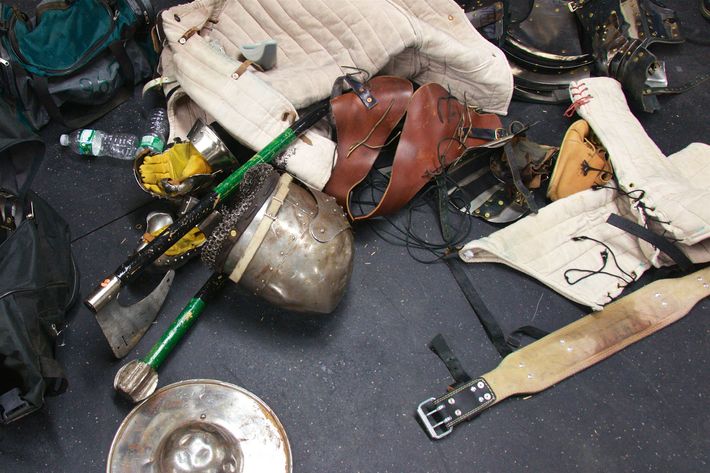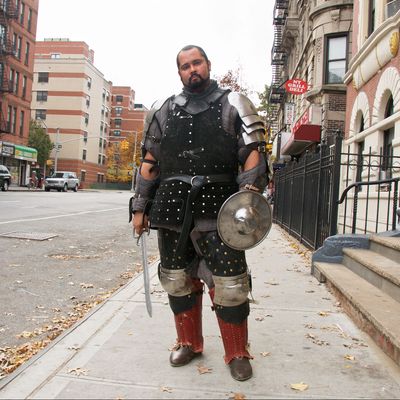
The stretch of Madison Avenue between 124th and 125th Streets has its Sunday soundtrack: a drum circle in Marcus Garvey Park, overlaid by sirens. Multiple hairdressers vie for trade, a pink-themed bakery sells sugar cookies by the pound, and Black Hebrew Israelites patrol outside a bodega that seems to host a never-ending kiki around its ice-cream freezer. Around the corner, police busted some pot dealers and found, along with guns and pit bulls, an eight-foot guard python. To add to the surrealism, I was once swooped by a red-tailed hawk while carrying laundry across the street.
And then the people with the swords showed up, some resembling samurais and others dressed for battle in Westeros.
Several months ago, I began to wonder when heavy construction began in the empty basement of a building behind my own. Until 2003, this basement had been the Mount Morris bathhouse, a gay cruising den that managed to endure through the worst days of the city’s AIDS crisis. (“I always tell the clients, ‘If I can’t bring my wife down here, it isn’t right,’” the old owner told the New York Times.)
Eventually a banner was erected outside the entrance, dispelling all concerns: “Sword Class NYC, Armored Marital Arts Training for Youth and Adults.” These arts include Siljun Dobup, kendo, armored combat league, and “historical European martial arts” based on the technique of Johannes Liechtenauer, a 14th-century German fencing master whose teachings were scribbled down in cryptic verse. The official name of Sword Class NYC is Sung Do Kwan — “Academy of the Sacred Sword.”
“There’s no business like this anywhere,” explained Raab Rashi, the director of Sword Class NYC, when I visited him in office, a chaotic jumble of unpacked computer equipment and heavy weaponry. “We’re the only school in the United States a hundred percent devoted to medieval fighting arts.”
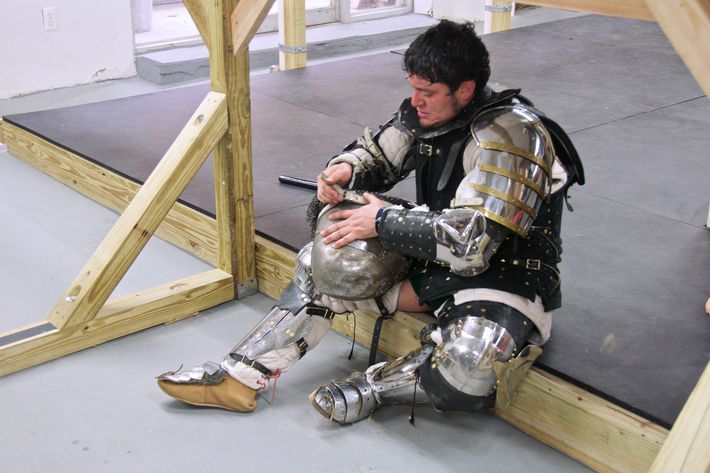
Rashi is from Dumont, New Jersey. “I always tell people I don’t have a very exciting, romantic story, like my parents being killed by ninjas,” he told me. Instead, and maybe unsurprisingly, he is a lifelong fan of movies like Star Wars, with its lightsabers, and Rashi took note when a kendo master happened to open a facility in his hometown. He joined and became obsessed, eventually giving up a job in arts management to fight full-time. Several years ago, he opened a studio of his own in Midtown East, then moved to Midtown West. The last move to Harlem, which required an extensive renovation, came only after Rashi’s business had acquired enough regulars interested in, among other things, “a really unique way to get in shape.”
Two of these students are Amelia Yankey and Eva Embers, who on the day I visited had just taken their first class in Liechtenauer techniques. “We’re social workers,” Yankey explained. “We have aggression.”
“Here is a problem that can be solved with the body instead of the mind and heart,” Embers added. Though she called herself “a big dork” — pink dyed hair, a Metroid Prime tattoo — she also hoped the sword-fighting would help her feel less frustrated at work: “I think it will, if I get to hit something.”
Rashi was quick to point out that many of the school styles are actually low-impact, involving nonfatal nylon swords or swords with the edges blunted. (“I like having students.”) Sharp swords are reserved for activities like test cutting: slicing tatami mats that have been soaked in water until they approximate the density of human muscle.
But then there is the Armored Combat League. When I arrived at the studio, three men in full plate armor were swinging at each other with weapons that were impacting in loud, resonant clangs, as though the Tin Man has multiplied and become a murderous psychopath. (A can of WD-40 sat on a counter.) ACL is like the Society for Creative Anachronism — those people who dress up at Renaissance fairs and spar in open fields, hoping that Tyrion Lannister might pop by for a draught — but treated as an actual sport with chapters and a national team.
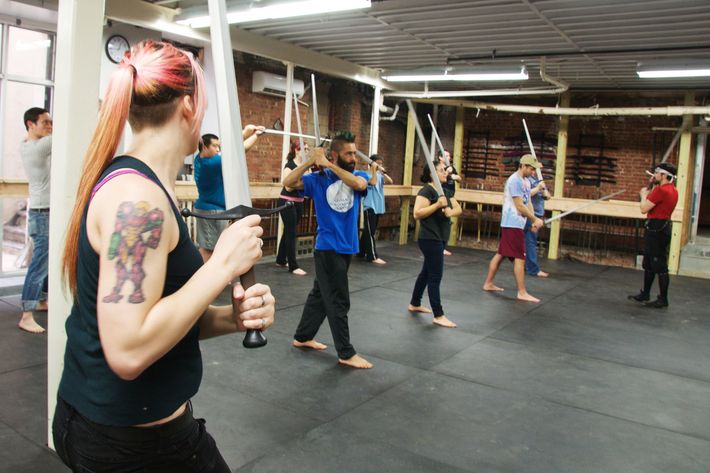
After the battle, which was over in minutes, I watched the men help each other shrug off vambraces and spaulders that weighed the equivalent of a small child. Rodney Versace, a professor of biochemistry, admitted to having opened a new credit card to pay for his kit, as Morgan Neyland, another social worker — I began to notice a theme here — passed me a mace. “That’s my favorite one to use,” he said. I turned it over in my hands, considering the possibilities, until the top fell off and hit the ground with the boom of a thousand migraines.
“Is it safe?” I asked.
“It’s safe — in its own way,” said Damion DiGrazia, captain of the New York chapter of the ACL, as he reclined languorously on the floor near a stray jockstrap. Sure, there was that guy at a recent tournament in Swedesboro, New Jersey, whose faceplate cracked, so when he was hit by an axe it went straight into his forehead, probably through bone, blood pouring out of two nasty gashes. “But that’s actually lucky that he got hit in the forehead,” DiGrazia clarified, “even though he could have brain damage, it’s possible, I don’t know, I haven’t heard about him since he left for the ER … ” He trailed off. The point is that he could have lost his nose, man.
“Once you start doing it and you don’t die,” Neyland said, jumping in, “you become like, ‘Huh, somebody has an actual mace and they’re coming at me, and I can withstand it.’” He smiled slyly, puffing his chest a little.
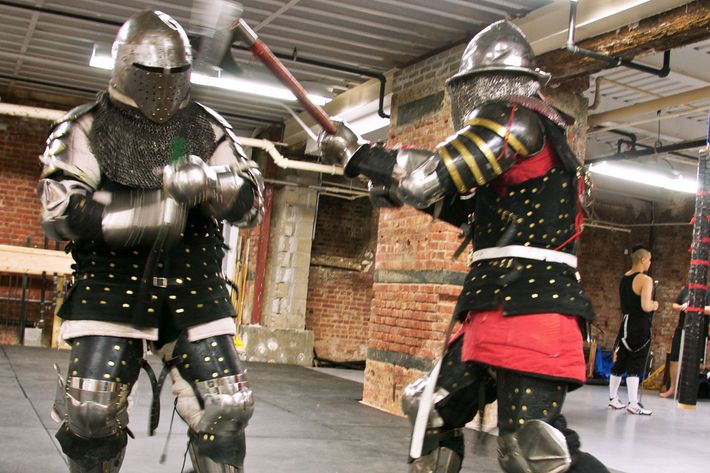
Like Yankey and Embers, these men suggested their interest in medieval violence is largely cathartic: DiGrazia, for example, is a management consultant at a major investment bank; he sits at a desk all day crunching data and then retreats to the mats to vent steam. That doesn’t mean he’s “a thug,” though. He teaches at Sunday school, he insisted on telling me; he escorted blind people in the New York Marathon. “First and foremost we’re gentlemen. I don’t like cursing in class or anything like that. I try to keep it clean here, even though we get rough.” You might break an arm, dislocate a shoulder, slice off a finger, but in the end it doesn’t matter, DiGrazia said. “We try to be good about this.”
In fact, DiGrazia, his nickname “the Arrow,” sees his fellow knights as ambassadors and Sword Class NYC as a new center for a sport he wants to make part of the city’s mainstream sporting scene. The problem is legitimacy — making something weird and fringe seem normal enough that audiences will support the local chapter in its bid for national glory. But, DiGrazia told me, fondling a piece of armor as he glanced around the professional space, which is not unlike a CrossFit gym, an American flag stapled to the wall: “I’m going to do it.”
